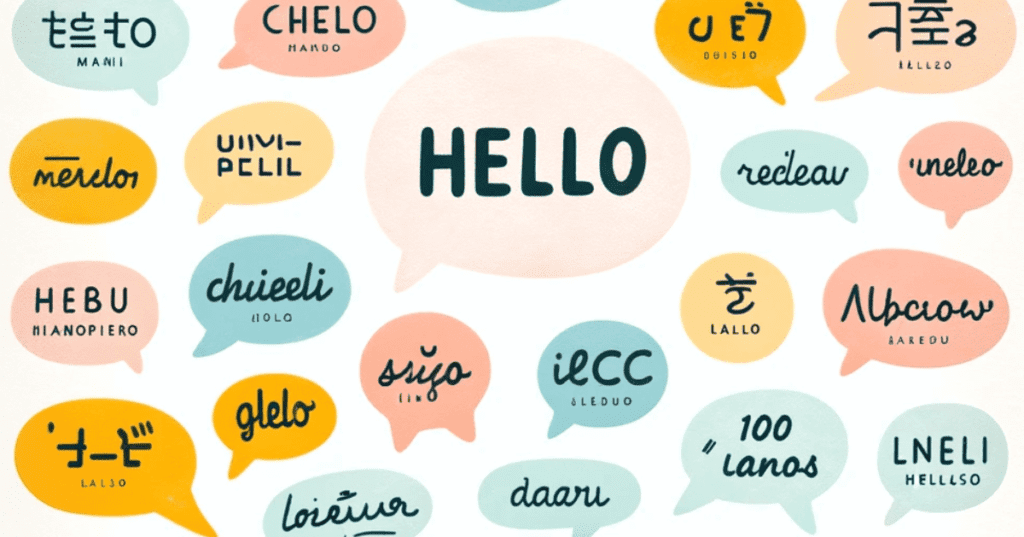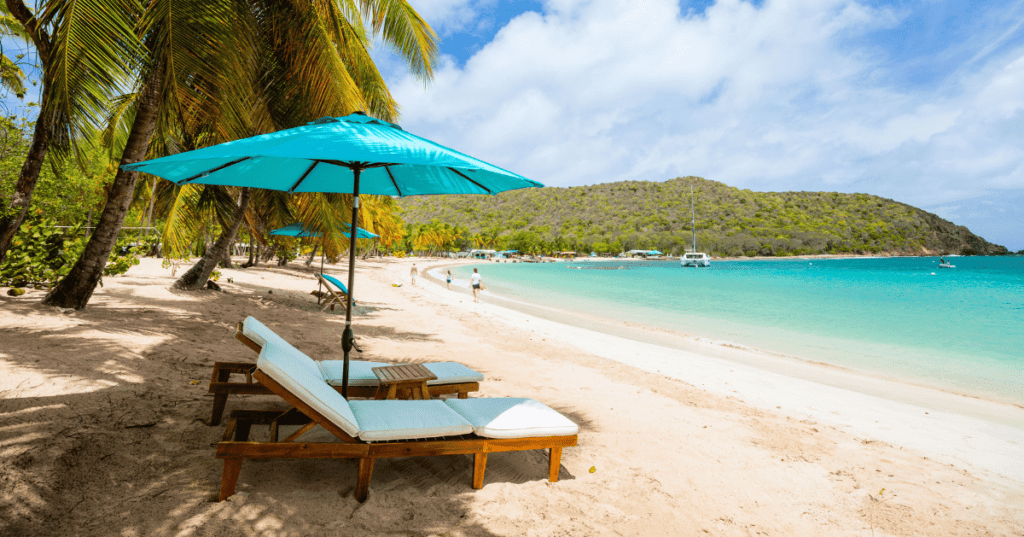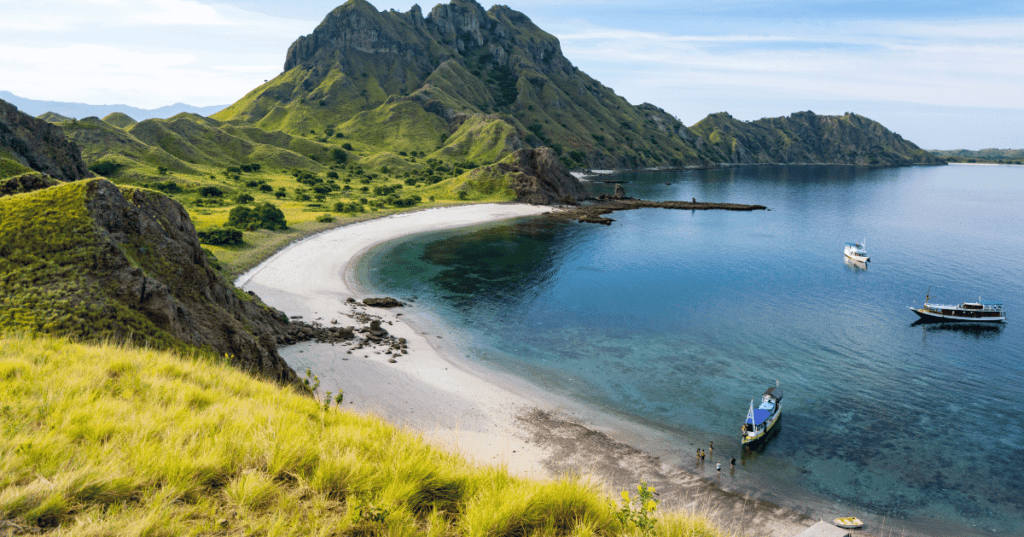Visiting a new country? Start with ‘hello’. It’s a small word with a big impact. I’ve been to many countries and different places with different languages and cultures, and saying hello in the local language always helps. It’s a simple way to connect, show respect, and make friends.
Learning languages can be tough, but ‘hello’ is easy. It is your first step in a new place. You don’t need to be fluent – just willing to try. And people appreciate that.
I know the struggle with languages. But starting with greetings? That was doable. It’s a great tool, especially for solo travelers. It opens doors and starts conversations.
This guide covers hello in 100 languages. I’ve chosen popular languages and checked pronunciations with native speakers. It’s a practical tool for every traveler. You’ll learn where and how to use these greetings.
Say Hello in 100 Languages With Pronunciation

Let’s explore ‘hello’ in 100 languages. It’s perfect for travelers or anyone curious about languages.
#1. English: Hello
English is a global language spoken by around 1.35 billion people. It’s the official language in countries like the UK, USA, Canada, Australia, New Zealand, and many African and Caribbean nations. It’s also widely used in India, Singapore, and parts of Africa and Oceania.
How you can pronounce it: huh-lOH
#2. Spanish: Hola
Spanish is primarily spoken in Spain and most countries in Central and South America, excluding Brazil. It’s also one of the most spoken languages in the United States.
How you can pronounce it: OH-lah
#3. Mandarin Chinese: 你好 (Nǐ hǎo)
Mandarin is the most spoken language worldwide, primarily used in China, Taiwan, and Singapore. Mandarin Chinese is not just the most spoken language but also features a complex writing system and tonal nature, making it unique among the world’s languages.
How you can pronounce it: nee-haow
#4. Hindi: नमस्ते (Namaste)
Hindi is one of the primary languages of India and is also spoken in some regions of Nepal. Hindi is written in the Devanagari script and shares many similarities with other languages of the Indian subcontinent.
How you can pronounce it: nah-mah-steh
#5. Arabic: مرحبا (Marhaba)
Arabic is widely spoken in the Middle East and North Africa, including countries like Saudi Arabia, Egypt, Iraq, and Morocco. Arabic is known for its rich literary history and is written in a unique script that reads from right to left.
How you can pronounce it: mar-hah-bah
#6. Portuguese: Olá
Portuguese is the official language of Portugal and Brazil, and is also spoken in former Portuguese colonies like Angola, Mozambique, Cape Verde, and East Timor.
How you can pronounce it: oh-LAH
#7. Bengali: নমস্কার (Nomoshkar)
Bengali is primarily spoken in Bangladesh and in the Indian states of West Bengal, Tripura, and Assam’s Barak Valley. Bengali has a rich literary heritage, with the national anthems of both Bangladesh and India penned in this language.
How you can pronounce it: no-moh-sh-kar
#8. Russian: Привет (Privet)
Russian is the most widely spoken language in Russia and is also used in Belarus, Kazakhstan, and many other countries in Eastern Europe and Central Asia.
How you can pronounce it: pree-VYEHT
#9. Japanese: こんにちは (Konnichiwa)
Japanese is the national language of Japan and is not widely spoken outside the country. Japanese has three different writing systems: Hiragana, Katakana, and Kanji, and it is known for its complex levels of politeness in speech.
How you can pronounce it: kohn-NEE-chee-wah
#10. Punjabi: ਸਤ ਸ੍ਰੀ ਅਕਾਲ (Sat Sri Akal)
Punjabi is spoken in the Punjab region of both India and Pakistan, with significant diaspora communities in the UK, Canada, and the USA. Punjabi is written in the Gurmukhi script in India and in the Shahmukhi script in Pakistan.
How you can pronounce it: sut sree ah-kal
#11. German: Hallo
German is predominantly spoken in Germany, Austria, and parts of Switzerland, Luxembourg, and Belgium. German is known for its compound words, creating some of the longest words in any language. It’s also the most widely spoken native language in the European Union.
How you can pronounce it: HAH-loh
#12. Javanese: Halo
Javanese is primarily spoken on the island of Java, Indonesia, by about half of the country’s population. Javanese, written in a script called Hanacaraka, has three distinct speech levels, each used depending on the social status of the person you’re speaking to.
How you can pronounce it: hah-LOH
#13. Wu (Shanghainese): 侬好 (Nóng hǎo)
Wu, including the Shanghainese dialect, is mainly spoken in the Shanghai region and parts of the Zhejiang and Jiangsu provinces of China.
How you can pronounce it: nong-hao
#14. Malay: Selamat pagi
Malay is spoken in Malaysia, Indonesia, Brunei, Singapore, and parts of Thailand. Malay has a significant influence on regional languages and is known for its relatively easy-to-learn grammar, with no conjugations, plurals, or gender-specific nouns.
How you can pronounce it: suh-LAH-mat PAH-gee
#15. Telugu: నమస్కారం (Namaskārām)
Telugu is predominantly spoken in the Indian states of Andhra Pradesh and Telangana, and in Yanam, where it’s an official language. Telugu is sometimes referred to as ‘The Italian of the East,’ due to its mellifluous nature.
How you can pronounce it: nah-mahs-KAA-raam
#16. Vietnamese: Xin chào
Vietnamese is the official language of Vietnam, spoken by around 85 million people. It’s also recognized as a minority language in the Czech Republic and Slovakia.
How you can pronounce it: seen chow
#17. French: Bonjour
French is widely spoken in France, parts of Canada (especially Quebec), Belgium, Switzerland, and many African countries. French is known for its influence on the arts and sciences and is one of the key languages of diplomacy and international organizations.
How you can pronounce it: bohn-ZHOOR
#18. Italian: Ciao
Italian is mainly spoken in Italy and southern Switzerland. Italian is known for its musical and poetic qualities, and it’s the language with the closest ties to Latin, the language of the ancient Roman Empire.
How you can pronounce it: chow
#19. Quechua: Rimaykullayki
Quechua is spoken in parts of Peru, Bolivia, and Ecuador. It’s an indigenous language with a rich history in the Andes.
How you can pronounce it: ree-mahy-koo-yah-kee
#20. German: Hallo
German is widely spoken in Germany, Austria, parts of Switzerland, and other European countries.
How you can pronounce it: HAH-loh
#21. Korean: 안녕하세요 (Annyeonghaseyo)
Korean is primarily spoken in South Korea and North Korea. The Korean alphabet, Hangul, was created in the 15th century and is praised for its scientific design and ease of learning.
How you can pronounce it: ahn-nyong-ha-se-yo
#22. Turkish: Merhaba
Turkish is spoken in Turkey and Cyprus, and it has minority language status in Kosovo, North Macedonia, and Romania. Turkish is known for its vowel harmony and extensive use of agglutination, which allows the addition of many suffixes to a base word.
How you can pronounce it: mehr-hah-bah
#23. Kirundi: Amakuru
Kirundi is spoken in Burundi. Burundi is known as the “Heart of Africa.”
How you can pronounce it: ah-mah-koo-roo
#24. Hindi: नमस्ते (Namaste)
Hindi is one of the primary languages of India, especially in the northern regions. Hindi, written in the Devanagari script, shares roots with Sanskrit and is influenced by Persian and Arabic.
How you can pronounce it: nah-mah-steh
#25. Ilocano: Kumusta
Ilocano is spoken in the Philippines. The Philippines consists of over 7,000 islands.
How you can pronounce it: koo-muh-stah
26. Urdu: اسلام علیکم (As-salāmu ʿalaykum)
Urdu is primarily spoken in Pakistan and is one of the 22 official languages of India, especially in Uttar Pradesh, Delhi, and Hyderabad.
How you can pronounce it: ass-sah-laam oo-ah-lay-koom
#27. Persian (Farsi): سلام (Salam)
Persian, or Farsi, is mainly spoken in Iran, Afghanistan (as Dari), and Tajikistan (as Tajik). Persian has had a major influence on neighboring languages and is known for its rich literature, including works by poets like Rumi and Hafez.
How you can pronounce it: sah-LAAM
#28. Swahili: Jambo
Swahili is widely spoken in East Africa, including Kenya, Tanzania, Uganda, and parts of Mozambique and Congo. Swahili has strong Arabic influences and is used as a lingua franca in East Africa, bridging various ethnic groups.
How you can pronounce it: jahm-BO
#29. Gujarati: નમસ્તે (Namaste)
Gujarati is predominantly spoken in the Indian state of Gujarat, as well as by Gujarati communities worldwide.
How you can pronounce it: nah-mahs-tay
#30. Amharic: ሰላም (Selam)
Amharic is the official language of Ethiopia and is also spoken in neighboring countries. Amharic is written in the Ge’ez script, which is one of the oldest writing systems still in use in the world.
How you can pronounce it: seh-LAHM
#31. Marathi: नमस्कार (Namaskar)
Marathi is predominantly spoken in the Indian state of Maharashtra and is also an official language in Goa. Marathi, with a history dating back over a millennium, is known for its rich literary traditions and is the third most spoken language in India.
How you can pronounce it: nah-mahs-kar
#32. Tamil: வணக்கம் (Vanakkam)
Tamil is primarily spoken in the Indian state of Tamil Nadu, Sri Lanka, and Singapore.
How you can pronounce it: vah-nah-kkum
#33. Ukrainian: Привіт (Pryvit)
Ukrainian is the official language of Ukraine. Ukrainian has its own Cyrillic script and is known for its melodic qualities, with a rich tradition in literature and folk songs.
How you can pronounce it: pree-veet
#34. Dutch: Hallo
Dutch is mainly spoken in the Netherlands, Belgium (Flanders), and Suriname. Dutch is the parent language of Afrikaans and has a significant influence on the languages of the former Dutch colonies.
How you can pronounce it: HAH-loh
#35. Russian: Здравствуйте (Zdravstvuyte)
Russian is the most widely spoken language in Russia, and it’s also spoken in many former Soviet states. Russian uses the Cyrillic alphabet and is known for its complex grammar, including six grammatical cases.
How you can pronounce it: zdrah-stvooy-tye
#36. Eastern Min: 你好 (Lí-hó)
Eastern Min is spoken in parts of China, Taiwan, and Southeast Asia. It’s one of the most widely spoken varieties of Min Chinese.
How you can pronounce it: lee-hoh
#37. Hungarian: Helló
Hungarian is the official language of Hungary. Hungary is renowned for its thermal baths and rich cuisine.
How you can pronounce it: heh-loh
#38. Dutch: Hallo
Dutch is the official language of the Netherlands and Belgium. Dutch is part of the West Germanic language family.
How you can pronounce it: hah-lo
#38. Swedish: Hej
Swedish is the official language of Sweden. Sweden has a strong tradition of English language proficiency, and many Swedes are fluent in English.
How you can pronounce it: hey
#39. Polish: Cześć
Polish is the official language of Poland. The Polish language features several unique characters not found in English.
How you can pronounce it: cheshch
#40. Sindhi: سلام (Salaam)
Sindhi is primarily spoken in Pakistan and India. Sindhi is written in both the Arabic and Devanagari scripts.
How you can pronounce it: sah-lahm
#41. Amharic: ሰላም (Selam)
Amharic is the official language of Ethiopia. Amharic is one of the oldest languages in the world and has its own unique script.
How you can pronounce it: seh-lahm
#42. Fula: Ñalawaa
Fula is spoken in West Africa, including countries like Nigeria and Niger. Fula is known for its rich oral tradition and history.
How you can pronounce it: nyah-lah-wah
#43. Romanian: Salut
Romanian is the official language of Romania and Moldova. Romanian is a Romance language, meaning it evolved from Latin.
How you can pronounce it: sah-loot
#44. Oromo: Akkam
Oromo is spoken in Ethiopia and parts of Kenya. Oromo has a significant number of speakers and is one of the major languages of Ethiopia.
How you can pronounce it: ah-kahm
#45. Igbo: Ndewo
Igbo is one of the major languages of Nigeria. Igbo has a rich oral tradition and is known for its proverbs.
How you can pronounce it: n-deh-woh
#46. Azerbaijani: Salam
Azerbaijani is primarily spoken in Azerbaijan. Azerbaijani is written in a modified Latin script in Azerbaijan.
How you can pronounce it: sah-lahm
#47. Awadhi: नमस्ते (Namaste)
Awadhi is spoken in parts of India and Nepal. “Namaste” is a commonly recognized greeting in many parts of the world.
How you can pronounce it: nah-mahs-teh
#48. Gan Chinese: 你好 (Nǐ Hǎo)
Gan Chinese is spoken in southern China. Chinese languages often use characters with different tones to convey meaning.
How you can pronounce it: nee haow
#49. Cebuano: Hello
Cebuano is one of the major languages of the Philippines. The Philippines is a multilingual country with many regional languages.
How you can pronounce it: heh-loh
#50. Kurdish: سڵاو (Slaw)
Kurdish is spoken in regions spanning Turkey, Iran, Iraq, and Syria. Kurdish is written in various scripts, including Latin and Arabic.
How you can pronounce it: slah-oo
#51. Serbo-Croatian: Zdravo
Serbo-Croatian is spoken in several countries, including Serbia, Croatia, Bosnia and Herzegovina, and Montenegro. Serbo-Croatian was once considered a single language, but it has since diverged into multiple standardized varieties.
How you can pronounce it: zdrah-voh
#52. Malagasy: Salama
Malagasy is the national language of Madagascar. Madagascar is known for its unique biodiversity.
How you can pronounce it: sah-lah-mah
#53. Saraiki: ہیلو (Hello)
Saraiki is spoken in parts of Pakistan. Saraiki has a rich tradition of poetry and music.
How you can pronounce it: heh-loh
#54. Sinhalese: හෙලෝ (Helo)
Sinhalese is the official language of Sri Lanka. Sinhalese script is written from left to right, and it has a rich literary tradition.
How you can pronounce it: hay-loh
#55. Chittagonian: হ্যালো (Helo)
Chittagonian is spoken in the Chittagong Hill Tracts of Bangladesh. It’s a member of the Indo-Aryan language family.
How you can pronounce it: heh-loh
#56. Zhuang: Bouinz
Zhuang is spoken by the Zhuang people in southern China. Zhuang has its own unique script, but it is often written using Latin characters.
How you can pronounce it: boh-eenz
#57. Khmer: សួស្តី (Sues’day)
Khmer is the official language of Cambodia. Khmer script is known for its elegant and intricate characters.
How you can pronounce it: soo-ehs-day
#58. Turkmen: Salam
Turkmen is the official language of Turkmenistan. Turkmenistan is known for its unique landscapes, including the Karakum Desert.
How you can pronounce it: sah-lahm
#59. Assamese: নমস্কাৰ (Nomoskar)
Assamese is spoken in the Indian state of Assam and other northeastern regions. Assamese culture is rich in traditional dance forms like Bihu and Sattriya.
How you can pronounce it: noh-mohs-kahr
#60. Madurese: Halo
Madurese is spoken on the Indonesian island of Madura. Madura is famous for its bull races, a unique cultural event.
How you can pronounce it: hah-loh
#61. Somali: Maalin Wanaagsan
Somali is the official language of Somalia and is also spoken in neighboring countries. Somalia has a rich oral tradition of poetry known as “Gabay.”
How you can pronounce it: mah-leen wah-nahg-sahn
#62. Marwari: नमस्कार (Namaskar)
Marwari is spoken in the Marwar region of Rajasthan, India. Marwar is known for its vibrant folk music and dance forms.
How you can pronounce it: nah-mahs-kahr
#63. Magahi: नमस्ते (Namaste)
Magahi is spoken in the Indian state of Bihar. Bihar is known for its historical significance, including the ancient university of Nalanda.
How you can pronounce it: nah-muh-stay
#64. Haryanvi: नमस्कार (Namaskar)
Haryanvi is spoken in the Indian state of Haryana. Haryana is famous for its traditional sports like kabaddi and wrestling.
How you can pronounce it: nah-mahs-kahr
#65. Hungarian: Helló
Hungarian is the official language of Hungary. Hungary is renowned for its thermal baths and rich cuisine.
How you can pronounce it: heh-loh
#66. Chhattisgarhi: नमस्कार (Namaskar)
Chhattisgarhi is spoken in the Indian state of Chhattisgarh. Chhattisgarh is known for its tribal culture and vibrant folk traditions.
How you can pronounce it: nah-mahs-kahr
#67. Greek: Γειά σας (Yia sas)
Greek is the official language of Greece and Cyprus. Greece is famous for its ancient history, including the Acropolis in Athens.
How you can pronounce it: yee-ah sahs
#68. Chewa: Moni (singular), Moneni (plural)
Chewa is spoken in Malawi and Zambia. Malawi, known as the “Warm Heart of Africa,” is famous for its friendly people and beautiful Lake Malawi.
How you can pronounce it: moh-nee (singular), moh-neh-nee (plural)
#69. Deccan: नमस्कार (Namaskar)
Deccan is spoken in the Deccan Plateau region of India. The Deccan Plateau is known for its historical monuments and diverse landscapes.
How you can pronounce it: nah-mahs-kahr
70. Akan: Ɛte sɛn (morning), Maakyɛ (afternoon), Maaha (evening)
Akan is spoken in Ghana and the Ivory Coast. Ghana is famous for its cocoa production and vibrant culture.
How you can pronounce it: ay-teh sehn (morning), mah-chyeh (afternoon), mah-hah (evening)
#71. Kazakh: Сәлеметсіздерге (Sälemetsizderge)
Kazakh is the official language of Kazakhstan. Kazakhstan is known for its vast steppes and diverse landscapes.
How you can pronounce it: suh-lem-et-siz-der-ge
#72. Northern Min: 你好 (Lí-hó)
Northern Min is spoken in southeastern China. Southeastern China is famous for its cuisine, including Fujian and Hakka dishes.
How you can pronounce it: lee-haw
#73. Sylheti: হ্যালো (Helo)
Sylheti is spoken in the Sylhet Division of Bangladesh and among the Sylheti diaspora. The Sylhet Division is known for its picturesque tea gardens and vibrant cultural heritage.
How you can pronounce it: heh-loh
#74. Zulu: Sawubona
Zulu is one of the 11 official languages of South Africa. South Africa is renowned for its diverse wildlife and stunning landscapes.
How you can pronounce it: sah-woo-boh-nah
#75. Czech: Ahoj
Czech is the official language of the Czech Republic. The Czech Republic is famous for its historic castles and delicious beer.
How you can pronounce it: ah-hoy
#76. Kinyarwanda: Muraho
Kinyarwanda is one of the official languages of Rwanda. Rwanda is known as the “Land of a Thousand Hills” due to its hilly terrain.
How you can pronounce it: moo-rah-ho
#77. Haitian Creole: Alo
Haitian Creole is primarily spoken in Haiti and by Haitian diaspora communities. Haiti is known for its vibrant music, including kompa and rara.
How you can pronounce it: ah-loh
#78. Eastern Min: 你好 (Lí-hó)
Eastern Min is spoken in Fujian Province and among overseas Chinese communities. Fujian is famous for its tea culture and coastal scenery.
How you can pronounce it: lee-hoh
#78. Ilocano: Naragsak a Panagkikinam(Iti)yo!
Ilocano is spoken in the Philippines, particularly in the Ilocos Region. The Ilocos Region is known for its stunning beaches and historic sites.
How you can pronounce it: nah-rahg-sahk ah pah-nahg-kee-kee-nahm(ee-tee)yoh
#79. Quechua: Sumaq kausay kani
Quechua is spoken in the Andean region of South America, including Peru and Bolivia. Machu Picchu, one of the New Seven Wonders of the World, is located in Peru’s Quechua-speaking region.
How you can pronounce it: soo-mahk kow-sigh kah-nee
#80. Kirundi: Amakuru
Kirundi is the official language of Burundi. Burundi is known as the “Heart of Africa” due to its central location on the continent.
How you can pronounce it: ah-mah-koo-roo
#81. Chichewa: Moni
Chichewa is also called Nyanja, Majorly it is spoken in Malawi, Zambia, Mozambique, and Zimbabwe.
How to Pronounce it: mooni
#82. Hmong: Nyob Zoo
Hmong is spoken by Hmong people in China, Vietnam, Laos, and Thailand. The Hmong are known for their vibrant traditional clothing and unique way of life.
How you can pronounce it: nyawb zoh
#83. Shona: Mhoroi
Shona is one of the 16 official languages of Zimbabwe. Zimbabwe is home to Victoria Falls, one of the largest waterfalls in the world.
How you can pronounce it: moh-roy
#84. Uyghur: ياخشىمۇسىز (Yaxşimusiz)
Uyghur is spoken in the Xinjiang Uyghur Autonomous Region of China. Xinjiang is known for its diverse culture and delicious Uyghur cuisine.
How you can pronounce it: yakh-shi-moo-seez
#85. Hiligaynon/Ilonggo: Hello
Hiligaynon, also known as Ilonggo, is spoken in the Philippines, particularly in the Western Visayas region. The Philippines is famous for its beautiful beaches and warm hospitality.
How you can pronounce it: heh-loh
#86. Mossi: Kibaré
Mossi is spoken in Burkina Faso. Burkina Faso is known for its vibrant music and dance traditions.
How you can pronounce it: kee-bah-rey
#87. Xiang Chinese: 你好 (Ní hǎo)
Xiang Chinese is spoken in Hunan province, China. Hunan cuisine is famous for its spicy and flavorful dishes.
How you can pronounce it: nee how
#88. Belarusian: Прывітанне (Pryvitanne)
Belarusian is spoken in Belarus. Belarus is known for its beautiful lakes and castles.
How you can pronounce it: prih-vee-tah-nye
#89. Balochi: سلام (Salaam)
Balochi is spoken in Pakistan, Iran, and Afghanistan. Balochistan is known for its rugged terrain and rich cultural heritage.
How you can pronounce it: sah-lahm
#90. Konkani: नमस्कार (Namaskar)
Konkani is spoken in Goa, India. It is famous for its beautiful beaches and vibrant nightlife.
How you can pronounce it: nah-mahs-kahr
#91. Georgian: გამარჯობა (Gamardjoba)
Georgian is spoken in Georgia. Georgia is known for its ancient wine-making traditions and stunning mountain landscapes.
How you can pronounce it: gah-mahr-joh-bah
#92. Maori: Kia Ora
Maori is spoken in New Zealand. The Maori culture is rich in traditional arts, including carving and tattooing.
How you can pronounce it: kee-ah oh-rah
#93. Armenian: բարև (Barev)
Armenian is spoken in Armenia. Armenia is home to the world’s oldest winery.
How you can pronounce it: bah-rev
#94. Waray-Waray: Hello
Waray-Waray is spoken in the Philippines. The Philippines is known for its stunning beaches and diverse marine life.
How you can pronounce it: Similar to English.
#95. Sesotho: Lumela
Sesotho is spoken in Lesotho and South Africa. Lesotho is a landlocked country entirely surrounded by South Africa, and it’s known for its mountainous terrain.
How you can pronounce it: loo-meh-lah
#96. Tigrinya: ሰላም (Selam)
Tigrinya is spoken in Eritrea and parts of Ethiopia. Eritrea is home to some of the most pristine coral reefs in the world.
How you can pronounce it: seh-lahm
#97. Latvian: Sveiki
Latvian is spoken in Latvia. Latvia is known for its beautiful forests and over 12,000 rivers and lakes.
How you can pronounce it: svei-kee
#98. Yiddish: העלאָ (A gutn tog)
Yiddish is spoken by Jewish communities worldwide. Yiddish is written in Hebrew script and has a rich cultural heritage.
How you can pronounce it: ah gootn tohg
#99. Kinyarwanda: Muraho
Kinyarwanda is spoken in Rwanda. Rwanda is known as the “Land of a Thousand Hills” due to its hilly terrain.
How you can pronounce it: moo-rah-hoh
#100. Haitian Creole: Alo
Haitian Creole is spoken in Haiti. Haiti shares the island of Hispaniola with the Dominican Republic.
How you can pronounce it: ah-loh
Final Thoughts on “Hello In 100 Languages”
After going through this guide, you can now say hello in 100 languages! It will be super helpful for your solo travels.
Even though I haven’t covered every language in the world, learning these 100 greetings has been a game-changer for me. It helped me connect with people in different places.
If you know of more ways to say hello in different languages, share them in the comments! I will add them in this list too.







